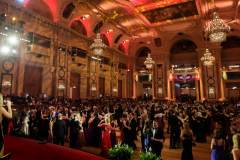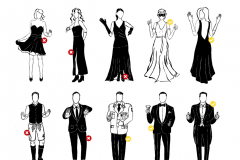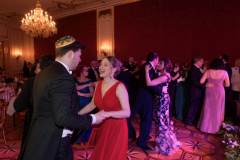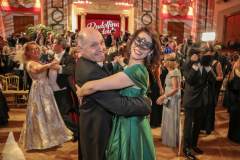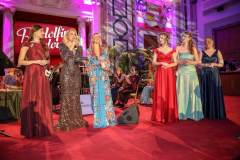Rudolfina Redoute Ball 2026
Mo | Tu | We | Th | Fr | Sa | Su |
Please note the free choice of seats at the tables and that you need an admission ticket along side a seating ticket.
Please note that no specific seat at the table will be assigned to a ticket.
Due to organizational reasons, table seats must be purchased in pairs
What is the Rudolfina-Redoute?
The Rudolfina Redoute is the oldest, most traditional ball organized by a student fraternity. Of the many Redoutes that once took place, the Rudolfina Redoute is the only one that still survives today. Redoute means “masked ball” where the ladies, who come alone or with a partner, wear a mask and can invite the men to dance. Every year on Carnival Monday (“Rosenmontag”), guests from all over the world come to the Vienna Hofburg for the Rudolfina Redoute.
All women, whether they are accompanied or not, are obliged to wear a mask. “Redoute” means masked ball, and the masks are essential for the most important aspect of the ball: only ladies who wear a mask can invite a gentleman to dance. After the de-masking Quadrille is danced, and ladies have removed their masks, both ladies and gentlemen can invite each other to dance until the ball ends at 5 a.m. As the last large ball before Lent, the Rudolfina Redoute is a glorious end to the Viennese Carnival season.
When attending extraordinary events it is custom to dress in a special way. Who would think of getting married in a blue collar or attend a formal with mountain boots? Even more the preparation for a ball night is part of the experience of the ball itself. The visit at the hairdresser’s, the sometimes a bit more difficult dressing and then a formal reception or a festive dinner. It all adds to the joy and anticipation of the evening so that the “Alles Walzer!” can be heard a lot more differently.
A ball that can’t be distinguished from the normal working place by decoration, music or entertainment would feel boring right away, because why should we attend an event that offers nothing else than what we have at work every day? And therefore the hosts of a ball try to create something special that remains in one’s memory, just like a trip to a forgotten world.
But for this trip to be a success we need your help. A single guest at the ball who arrives not dressed accordingly can destroy the whole impression for everyone. It is because of this that many balls at the Hofburg Vienna – and amongst them the Rudolfina-Redoute – require a special dress code. If you stick to it as well, the ball will be even more of a special experience – and you avoid having exhausting discussions with us at the entrance.
Thank you for your understanding and cooperation and let’s have a great ball night!
Ladies
Ladies wear a long evening gown at the Rudolfina-Redoute. The edge of the gown touches the floor all the way round – even when you are wearing high heels. A dress that ends at your ankles is too short, as well as an asymmetrical dress that touches the floor at the back, but not at the front. If your gown has a slit, please make sure it closes below the knee.
Furthermore ladies at the Rudolfina-Redoute wear a mask, that covers parts of the face, but mostly the eyes. Masks as worn in the operetta “Die Fledermaus” (“The Bat”) are the model for the masks that should be worn at the Rudolfina-Redoute. As a side note: For ladies wearing a masked there is a special deal called “Damenwahl” (“Ladies’ Choice”) until midnight, which means that ladies wearing masks are allowed to ask any man at the Rudolfina-Redoute for a dance.
Paintsuits, cocktail dresses or traditional dresses, such as Dirndls, do not fulfil the requirements of the dress code.
Gentlemen
Gentlemen attend the Rudolfina-Redoute in black tail with white bow tie, tuxedo with black bow tie or uniform. Please note that black and white tie have to be in the “classical style”, which means black with black shoes. A black tail consists of a white shirt, a white vest and a white bow tie, a tuxedo goes with black cummerbund and black bow tie. Ties, neckties and cravats are not allowed. Uniforms can only be worn if they are part of current military units. Historical uniforms are not to be worn.
Gentlemen do not wear masks at the Rudolfina-Redoute.
Not allowed are kilts, cuts and coloured tails or jackets or any other form of fancy dress or costume.
Even though “Redoute” can be translated as “masked ball” costumes of any kind are not allowed.
Guests whose outfit does not conform to the dress code will not be permitted entry to the ball.
Program and cast
The programme of the Rudolfina-Redoute 2026 is currently being worked out. As a preview we’re presenting this years’ programme.
Detailed programme of the Rudolfina-Redoute 2025
07:30 p.m. Doors open
09:00 p.m. Opening ceremony starts
11:30 p.m. Live opening show of Peter Sax in the disco (Gardehalle I und Forum)
11:40 p.m. Presentation of the Vienna’s most attractive mask
12:00 a.m. De-masking Quadrille in the main hall
00:30 a.m. Dancing for continues (Ladies’ and Gentlemen’s choice)
01:00 a.m. Live performance of Peter Sax in the disco (Gardehalle I und Forum)
01:30 a.m. Quadrille in the Heurigen on ground floor
02:00 a.m. Quadrille in the main hall
02:30 a.m. Live performance of Peter Sax in the disco (Gardehalle I und Forum)
03:30 a.m. Quadrille in the Rittersaal
04:25 a.m. traditional last waltz “Brüderlein fein” in the main hall
04:30 a.m. end of the ball
Vienna Hofburg Kongreszentrum
The Kaiserball developed from the imperial tradition of the so called “Hofball” (court ball) and “Ball bei Hof” that were organized by the imperial couple Franz Joseph (1830–1916) and his wife Empress Elisabeth (1837–1898), who is better known as Sisi. Both ball events were taking place in the Hofburg being the imperial winter residence of the Habsburg family.
The Hofball used to take place towards the end of January, with Empress Elisabeth deciding the precise date. Once the court had gathered in the Zeremoniensaal - which is still one of the most stunning rooms at the Hofburg to this day- selected guests were invited to pay their respects to the Emperor and Empress in person. The popular buffet was set up in the nearby Grosser Redoutensaal. Meanwhile the dance floor was positively brimming with activity - after all some 2,000 ballgoers were in attendance. The last waltz commenced at exactly quarter past midnight, and drew this spectacular imperial event to an end.
The “Ball bei Hof” took place just two weeks later. This more intimate event, reserved for the ruling elite, drew around 700 high-ranking royals and members of the diplomatic corps. To qualify as "Hochadel" (higher nobility), aristocrats were required to demonstrate a lineage going back at least eight generations on both the maternal and paternal sides.The most valuable porcelain in the imperial dining service was unpacked for a formal dinner which was served in the Radetzky apartments and neighbouring rooms. The strict seating order was dictated by rank. Ladies spared no expense and took every care to ensure their appearance matched the occasion, happily parting with between 300 and 500 Gulden for an evening dress - more than the annual income of a court servant.

 EN
EN DE
DE IT
IT FR
FR ES
ES RU
RU JP
JP RO
RO
 Seating plan
Seating plan 